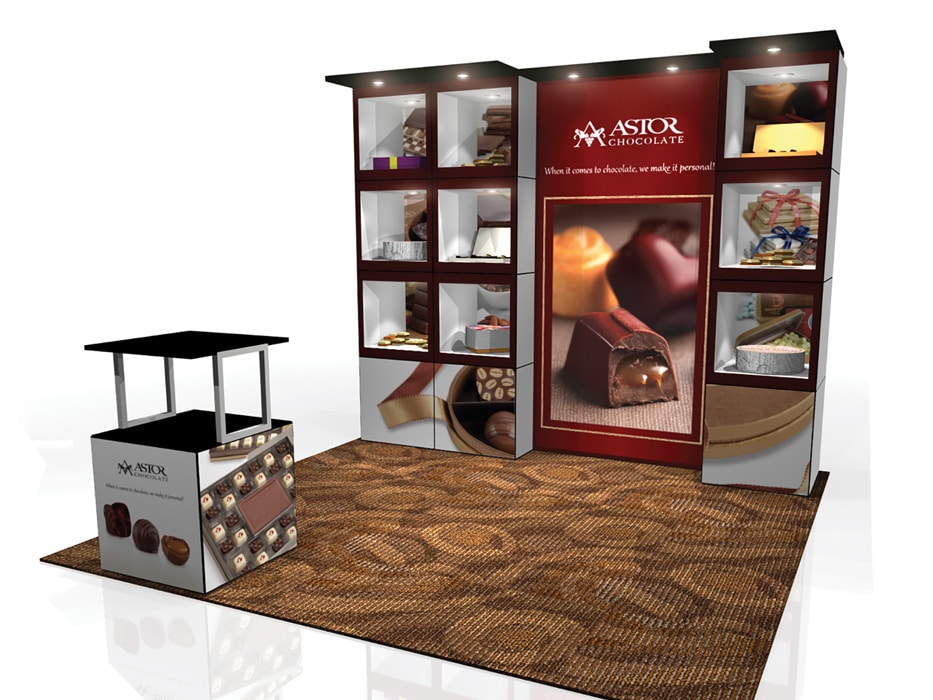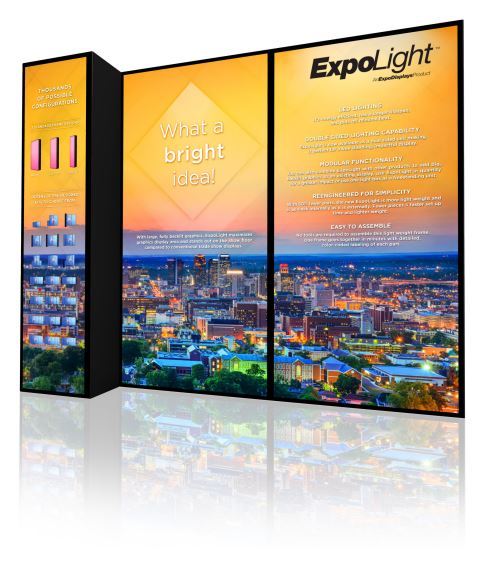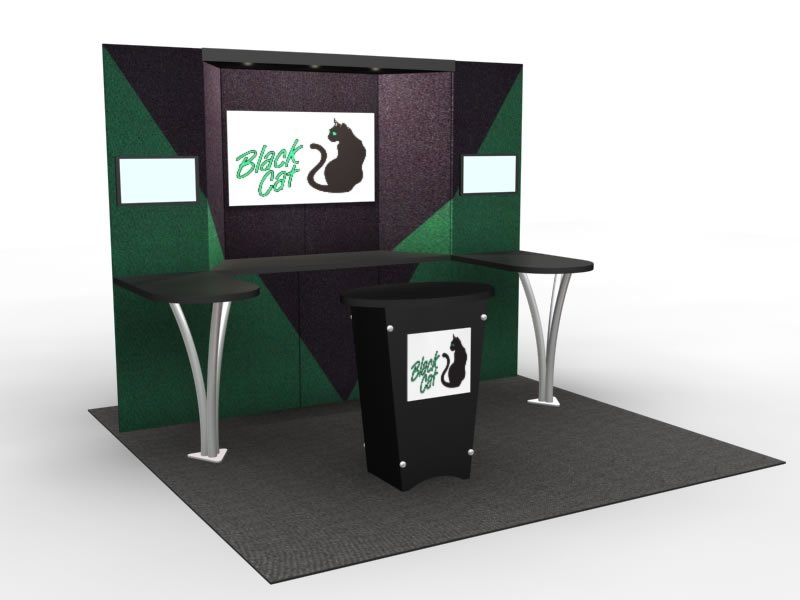Trade Show Booth – Modular Panels
Trade Show Booths with Modular Panels Provide a Premium Appearance
A prefabricated exhibit system that comes in various shapes and sizes may be just what you need for your next trade show. They are interchangeable and allow you to create something unique for your brand with different textures and designs.
Today we will take a much closer look at modular trade show booths and the trade show wall to show you how you can stand out more effectively and gain the attention of trade show attendees.
What is a Modular Trade Show Booth?
Modular trade show booths and displays have been around and popular for over 20 years. They used to be called folding panel displays, display panels, and trade show panel displays. The important word, and component, are the trade show walls or trade show booth walls that make these modular displays.
The booth display walls used in trade show display panels started out from plywood, but these days are primarily made from aluminum composites, di-bond, or other composite materials, typically based on a very lightweight honeycomb interior of some sort, covered by two very thin, rigid aluminum sheets.
A trade show wall is finished with either a molded plastic frame or an aluminum frame. The finish on the ends and sides of the trade show wall can vary between manufacturers, with the inexpensive displays having exposed plastic or metal and other designs electing to cover everything with fabric to provide a cleaner appearance.
On the outside faces, trade show booth walls can be covered with a variety of finishes – the most common for trade shows is Velcro receptive fabric, but paint, printed graphics, 100's of different laminates, slat and grid wall, and a variety of other exterior surfaces are available.
Often, a panel display will come with different finishes on front and back, either different fabric colors on each side, or possibly fabric on one side and a graphic design on the other, or fabric and slat wall, etc. This offers two advantages: first, the trade show booth can be used with either side facing forward, providing two different looks, and second, it also allows the display panels to be used as a double-sided display.
Panel Sizing
Trade show booth wall sizes vary slightly, depending on the manufacturer; typically, they are about 2ft wide by 3ft tall. Single panels are often used as stand-alone signage; however, trade show displays are most often made by combining panels into groups of 3, 4, 5, and 6 panels at a time.
Panels are normally joined with a bendable hinge, and hinge construction is one of the main differences between inexpensive panel displays, which may offer a simple cloth hinge, and the more expensive units, which may offer a 360-degree beveled gear hinge.
A modular trade show booth display typically uses folding panels in a single row for tabletop displays. The trade show booth walls are then stacked in two rows for floor standing displays. In larger panel displays with two rows of panels, either row can be configured to work on a tabletop.
The bottom row in a full-size trade show panel display often has feet on it; some systems include an adjustment on the feet to compensate for uneven floors. The top row of panels uses pins sticking out the bottom of the panels that go into receiving holes on the top of the bottom row of panels, allowing the two rows of panels to stack on each other.
Depending on the number of panels, the larger 5 or 6-panel strips usually need two people for setup and take-down.
Three and four-panel trade show wall systems can be used to build towers and counters, as well as back walls. The five and six-panel systems can easily fold panels back out of the way, if needed, to fit into smaller spaces, and these panel displays can also be combined to form larger, 20ft systems.
As you might imagine, for a 20-year-old system, there are many different accessories available for trade show panel kits, including a variety of headers, lights, external and internal shelves, etc.
There are a few derivatives of trade show booth walls that have evolved over the years. One of these is the Pole Panel display system (pictured above). This uses a panel very similar to those used in standard panel displays, except these panels are typically slightly larger, used one at a time, and connect to each other by a fastener that hooks into a post or pole the name, pole panel displays.
This arrangement offers a slightly different look. The poles are available in different heights, allowing the panel displays to be raised or lowered and allowing a single row of panels to be placed 3 feet off the floor, held up by the poles.
Panels can also stack two up to create configurations similar to the standard folding panel displays, but with a slightly different look. Pole panel systems are often seen at art shows and toy shows, and similar trade show venues. These systems are typically fairly heavy-duty and are suitable for high usage requirements and holding heavier display items.
THE GRAVITEE ONE-STEP™ MODULAR SYSTEM
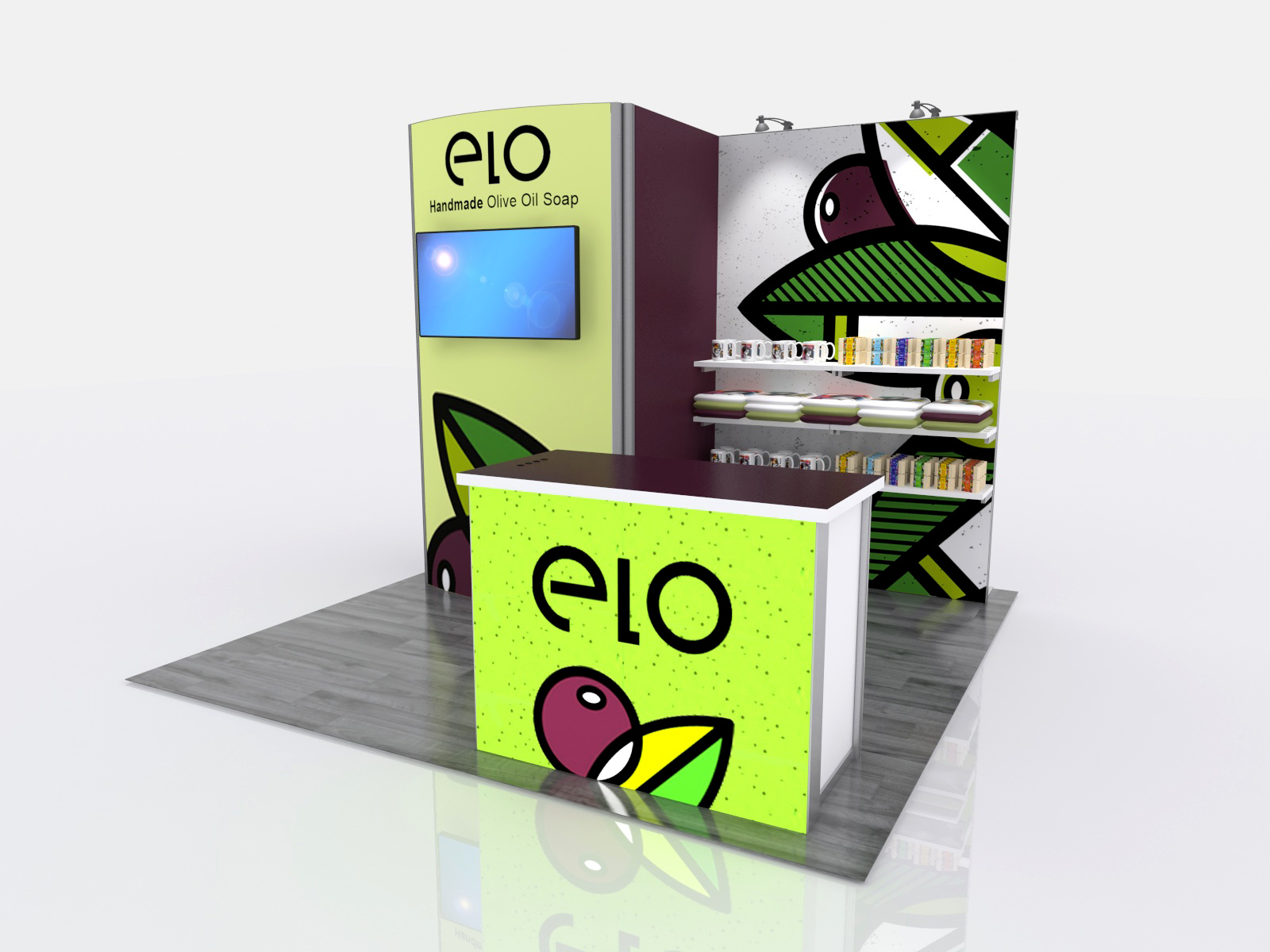
Unlike most existing modular wall systems, Gravitee doesn’t rely on loose connectors to attach panels, either vertically or horizontally. Instead, Gravitee connectors are built into the panels.
No need to wear an apron to hold bullet connectors while assembling the system. And no lost parts and pieces to replace after the show.
The Gravitee Systems assembles fast, meaning lower labor costs, whether the exhibit is an inline or island. Fewer parts and pieces also translate into lower material handling charges.
The Gravitee One-Step Modular Wall System is a one or two-sided display system that assembles without tools or loose parts. The individual panels connect horizontally with attached clips and a spring-loaded plunger. The panels can be stacked using an attached locking spring connector.
The Gravitee System accepts SEG fabric or direct print graphics (Velcro or magnet). It's the ideal wall system for trade shows, events, and retail environments since it assembles quickly, and the lightweight aluminum frames reduce shipping and material handling charges.
Features and Benefits:
MultiQuad Trade Show Booth
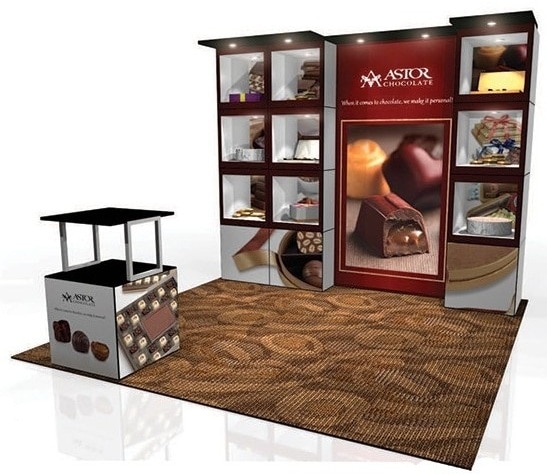
The last panel display derivative to mention is the MultiQuad Trade Show Booth. This system uses lightweight aluminum framing, in rectangular shapes of varying heights, to quickly assemble into 1ft or 2ft deep, box-like frames. Magnetic tape is used on the frames, and magnetic graphic panels quickly snap onto the MultiQuad displays.
The aluminum frames are lightweight, allowing for inexpensive shipping. However, the frames are fairly structural and will easily provide support for large screen monitors, internal shadow boxes and shelving, etc.
Graphics are about 2ft square in front and back, 1ft wide on the sides, and can be printed on translucent panels for backlit effects. The graphic panels are typically laminated to protect the graphic and pack flat into a case or box for transport.
Graphic panels can also accommodate almost any other finish available, including Velcro receptive fabric and 1,000’s of laminates. Exhibitors can reduce costs by skipping panels on the backside of their trade show walls unless that backside will be exposed and can also use the interior of the MultiQuad panels for easily accessible storage containers.
ExpoLight Displays
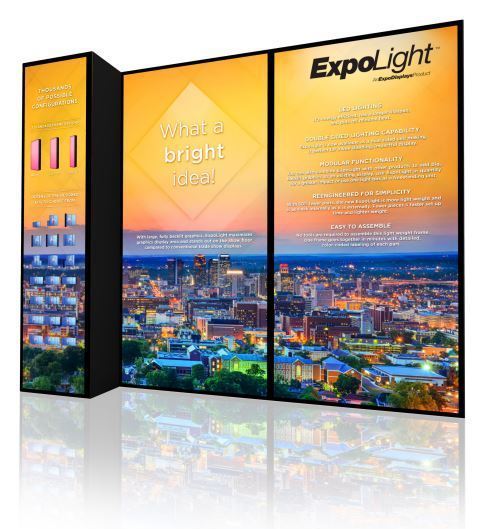
Another display panel derivative that is becoming popular recently is the ExpoLight panel system. The ExpoLight is built with a similar frame system as the MultiQuad, but with sections that aren't as deep and don't take as much room away from the booth. Inside is the "secret sauce"; ExpoLight panels are almost all backlit. The backlighting uses LEDs for maximum durability; the LED light source installs quickly, also without any tools.
The ExpoLight graphic panels are easily reconfigured into various shapes and configurations by combining the different sizes and shapes and hinges in different ways. Trade show booth wall designs made with these panels tend to have rectangular shapes and returns, allowing the panel displays to be stable without adding feet. The panels attach to the frames magnetically, with magnetic tape on the panel and the frames. As one might imagine, these graphic panels can be swapped out almost instantaneously. Shelves, lights, monitor and iPad mounts, podiums, and case wrapped graphics are available for the ExpoLight displays.
Summary
In summary, standard trade show booth display walls are a little bulkier to ship than pop up displays or the newer hybrid systems, primarily because the trade show walls themselves are rigid and take up a fair amount of space – this normally means an extra shipping case, compared to a pop up or hybrid system.
However, folding panel displays are fairly thin, so they take up less room in a trade show booth. They also line up tightly, creating a crisp and professional-looking trade show display. Using a fabric-covered panel face means the graphics can be changed in a few seconds, even during a show. And of course, a true tool-less setup means no expensive union help required...
The Pole Panel kits are about the same weight and take up the same number of shipping cases as a regular folding panel display. The only real advantage besides the different look is raising the row several feet off the floor, using the poles as the support. If that is a requirement, maybe for an art show, then these are good solutions.
The Gravitee is the newest design and offers a tool-less design without loose connectors. This may seem like a small difference, but if you use hired labor to set up and dismantle your booth, you already know that they lose the connectors. In fact, they lose a LOT of connectors. The Gravitee designs snap together without loose connectors, saving you time and money.
Bottom line, as with many trade show booth structures, a lot comes down to the eye of the beholder and whether the viewer likes the look and feel of a particular system.
Trade Show Wall FAQ
While we have given you tons of helpful information regarding trade show walls and modular trade show booths, you may still have some lingering questions. Review our FAQ below for the answers to some of the more commonly asked questions.
Why choose back wall displays?
When you have an adjustable back wall display for your trade show booth, it becomes much easier to change the size of your display when needed. You can also purchase graphics of different sizes while still using the same hardware on different sized displays. Back wall displays are a good option for exhibitors who attend shows with multiple trade show booths.
How do I get my trade show booth to stand out?
To ensure that your trade show booth stands out, you want to start planning early. Promote your booth on social media, host a booth event, offer something unique, and make your booth engaging and interactive. The exhibit doesn't have to be all work and no play. Design it how you see best to attract attendees and spark up a conversation about your products.
What is the difference between trade show back walls?
Trade show back walls and other trade show display options have certainly continued to evolve over time. You are no longer limited to a simple pop up display or grid wall system. Now you have a variety of different options to choose from so you can find what will work best for you. The differences really come down to the features and how the trade show back wall is constructed. You can find portable, modular, and custom trade show back walls.
What are the different types of trade show back walls?
As we have already stated, there are portable, modular, and custom trade show back walls you can choose from for your exhibit. Modular systems are among the most popular these days because of the varying booth sizes. Instead of having a different booth for each configuration you have, you can have one frame system that will work for each size.
Custom back walls are a good solution if you want a custom booth while still making modifications as needed. You can choose your color, add shelving, and more to set up the best design and display for your booth.

